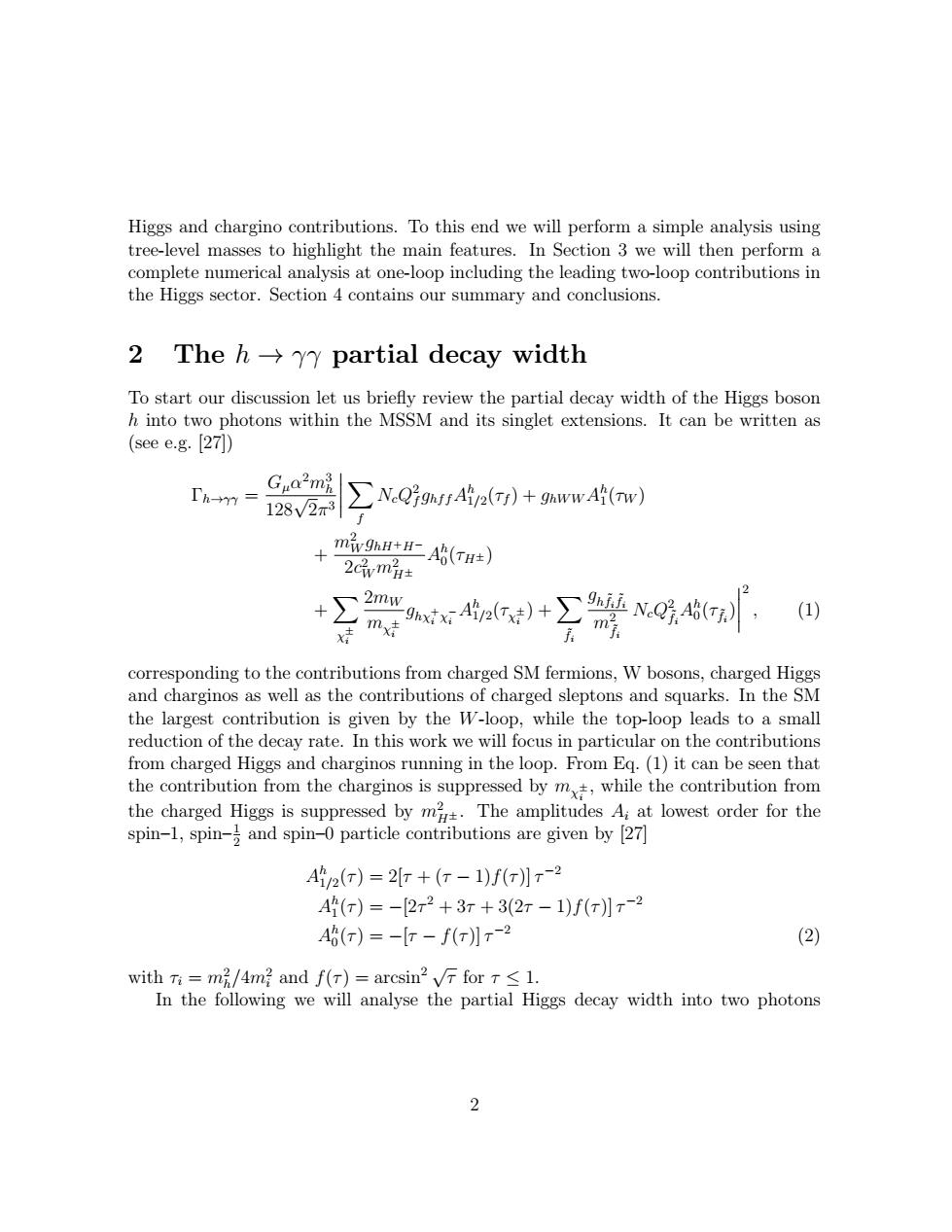正在加载图片...

Higgs and chargino contributions.To this end we will perform a simple analysis using tree-level masses to highlight the main features.In Section 3 we will then perform a complete numerical analysis at one-loop including the leading two-loop contributions in the Higgs sector.Section 4 contains our summary and conclusions. 2 The h->yy partial decay width To start our discussion let us briefly review the partial decay width of the Higgs boson h into two photons within the MSSM and its singlet extensions.It can be written as (see e.g.[27) Ih-= Gua2m 128V2m3 ∑N.Q号giA2(r)+gwwA(nw) m9hH+H二A6(rH±) 2cwmH± +∑2mw e+2a mx (1) x corresponding to the contributions from charged SM fermions,W bosons,charged Higgs and charginos as well as the contributions of charged sleptons and squarks.In the SM the largest contribution is given by the W-loop,while the top-loop leads to a small reduction of the decay rate.In this work we will focus in particular on the contributions from charged Higgs and charginos running in the loop.From Eq.(1)it can be seen that the contribution from the charginos is suppressed by m,while the contribution from the charged Higgs is suppressed by m.The amplitudes A:at lowest order for the spin-1,spin-and spin-0 particle contributions are given by [27] A/2(r)=2r+(r-1)f(r】r-2 A(r)=-2r2+3r+3(2r-1)f(r月r-2 A6(r)=-r-f(r〗r-2 (2) with T=m/4m?and f(r)=arcsin2vT for T 1. In the following we will analyse the partial Higgs decay width into two photons 2Higgs and chargino contributions. To this end we will perform a simple analysis using tree-level masses to highlight the main features. In Section 3 we will then perform a complete numerical analysis at one-loop including the leading two-loop contributions in the Higgs sector. Section 4 contains our summary and conclusions. 2 The h → γγ partial decay width To start our discussion let us briefly review the partial decay width of the Higgs boson h into two photons within the MSSM and its singlet extensions. It can be written as (see e.g. [27]) Γh→γγ = Gµα 2m3 h 128√ 2π 3
X f NcQ 2 f ghf fA h 1/2 (τf ) + ghWW A h 1 (τW ) + m2 W ghH+H− 2c 2 W m2 H± A h 0 (τH± ) + X χ ± i 2mW mχ ± i ghχ+ i χ − i A h 1/2 (τχ ± i ) +X f˜ i ghf˜ if˜ i m2 f˜ i NcQ 2 f˜ i A h 0 (τf˜ i )
2 , (1) corresponding to the contributions from charged SM fermions, W bosons, charged Higgs and charginos as well as the contributions of charged sleptons and squarks. In the SM the largest contribution is given by the W-loop, while the top-loop leads to a small reduction of the decay rate. In this work we will focus in particular on the contributions from charged Higgs and charginos running in the loop. From Eq. (1) it can be seen that the contribution from the charginos is suppressed by mχ ± i , while the contribution from the charged Higgs is suppressed by m2 H± . The amplitudes Ai at lowest order for the spin–1, spin– 1 2 and spin–0 particle contributions are given by [27] A h 1/2 (τ ) = 2[τ + (τ − 1)f(τ )] τ −2 A h 1 (τ ) = −[2τ 2 + 3τ + 3(2τ − 1)f(τ )] τ −2 A h 0 (τ ) = −[τ − f(τ )] τ −2 (2) with τi = m2 h /4m2 i and f(τ ) = arcsin2 √ τ for τ ≤ 1. In the following we will analyse the partial Higgs decay width into two photons 2